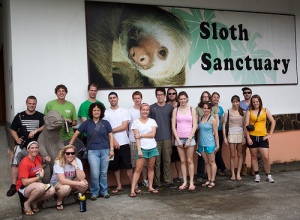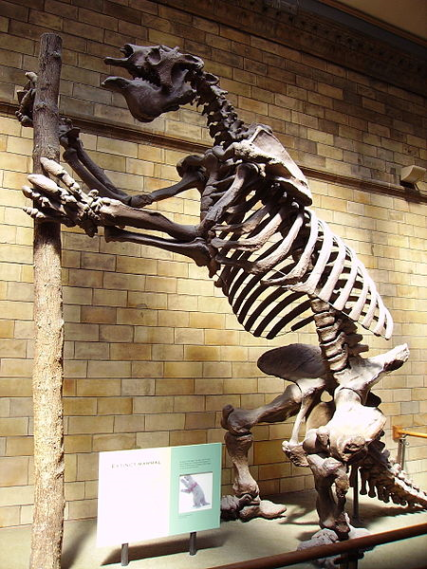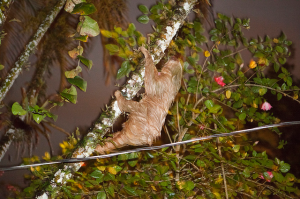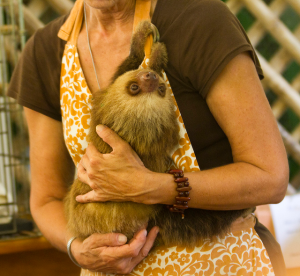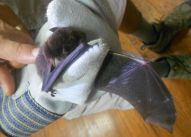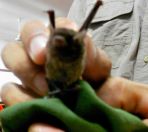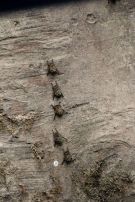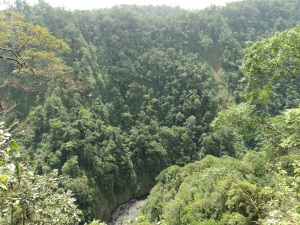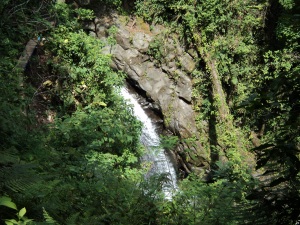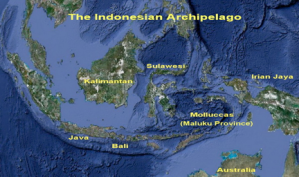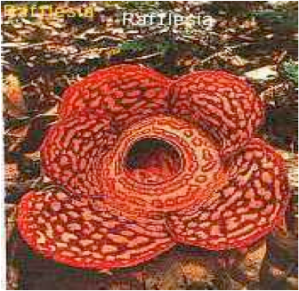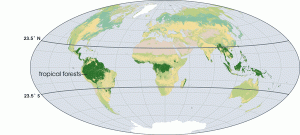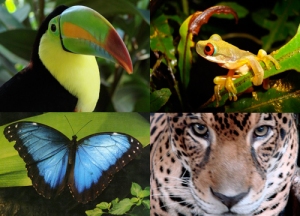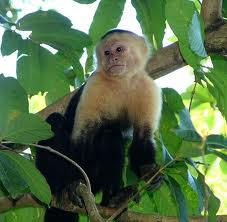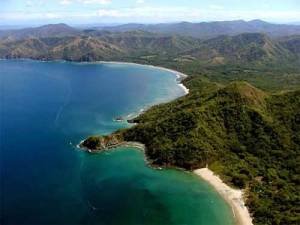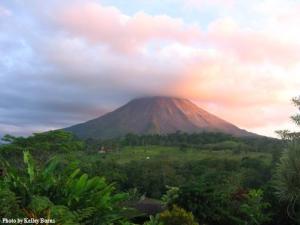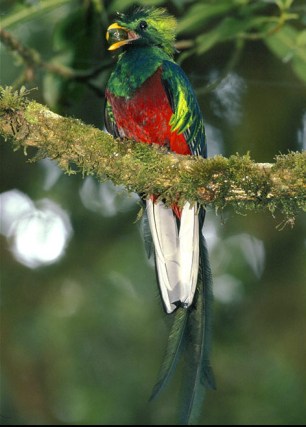Polly Wanna Adaptation?
Different Adaptations of Birds in the Tropics
In this blog we are going to explore characteristics of tropical birds that have many unique adaptations that occur nowhere else in the world. We also included adaptations of specific species, such as the parrot, hoatzins and hummingbirds. Before talking about different adaptations it is important to know how birds have evolved to bring about unique adaptations throughout the tropics.
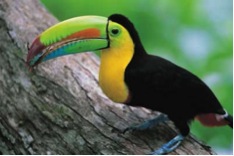
Keel-Billed Toucan
Speciation:
Specific habitats for specific species:
Tropical Birds are so incredibly diverse in the tropics for a number of reasons. Since the tropics are so diverse to begin with, one can easily see why. With so many niches, plants, and organisms to live and feed on, tropical birds will always flourish. As long as resources are available, birds will be able to adapt and evolve that will allow them to survive. The different landscapes and plants which can grow in the tropics and nowhere else provide a key reason why so many birds thrive. An example of this is the toucan. Toucans only reside in places where dense woodlands cover slopes at higher elevations. This is key because it is where the humidity is high, the temperature low, and mosses and lichens cover branches and trunks just the way toucans like it. This is just one example of many that show how slight variations of climate and resources can provide for unique birds. It is very interesting to understand because it is not just one thing which provides for these birds. The biodiversity of all living things in the tropics correlates causing so many variations. Just as was seen with the toucan, the branches, mosses, climate, and elevation all coexist to provide for a unique creature in a unique area of the world. With such a variety, the toucan can adapt in its own way using its giant colorful beak. This beak is used for specific foods as well as for camouflage in the rain forest. Almost every bird is different in its own way adapting to its environment. Even environmental changes from human interference can cause speciation among tropical birds.
One would think that there would be much lower numbers of birds in the deforested areas, but there were some species of birds that were more likely to be found in deforested areas than non-deforested areas. Undergrowth insectivores such as Orthotomus artrogularis and Trichastoma rostratum were more likely to be found in recently deforested areas than non- deforested areas. Although, many insectivores that were canopy bark gleaning species were negatively affected by deforestation, especially the hornbills. Even though deforestation may support many species of birds the sensitivity of the hornbills will cause a decline in seed dispersal for trees they are associated with, into logged areas.

Deforested foothills of Monteverde and mountains in Costa Rica
Speciation due to Isolation of glaciers:
There are a number of reasons why tropical bird species are so numerous and diverse. The main reason comes as a result of the general diversity of all species in that region. All over the world, the tropics on the equatorial band are a hotbed of species diversity, and this characteristic provides plenty of opportunities and pressures for bird species to specialize to the point of divergent evolution. Some more detailed theories specific to the neo-tropics highlight the geo-biological effects that receding glaciers had on bird species. The theory holds that the changing geography created a number of distinct refuge areas that sectioned populations and enhanced speciation rates. A competing theory argues that the relative climactic stability of the tropics created an environment where selective pressures favored speciation and specialization among bird species, a characteristic not found further from the equator. Most likely it is a combination of the two that led to the phenomenally speciose phylogeny found in the tropics, and the neo-tropics in particular.
Speciation from Specific Diets:
One factor that can determine the types of adaptions of birds is based on what food they eat. Birds adapt their habitat location and some morphological features like beak size based on the type of food they eat. In the tropics, the food sources are so diverse that bird species can become very specialized in eating whatever food source they live off of. Some birds that eat insects and the types of adaptive strategies that a bird could have to eat certain insects are caused by a number of reasons. First they can adapt in the way they gather their food: hunting upon the wing, digging deeply into wood, picking bugs off of leaves etc. Second they can adapt in how specific their diet is by being generalists or specialists. This will affect where they live, how social they are, and the beak morphology. Birds that are specialists will have to live very close to their food sources and possibly have a beak specialized to eat certain kinds of insects. Birds that are generalists will be able to live in a wider range of habitats and have a more generalized beak structure. By combining these two types of strategies, the possibilities of bird variation are almost endless. Food is not the only thing that influences these adaptations, but is a key factor. The amazing amount of insect diversity allows for such a large amount of bird diversity and specialization that is apparent in the tropics.
General bird characteristics that show different adaptations among species:
Birds are a group of diverse and interesting animals. They have developed several adaptations that have allowed them to inhabit a large range of land.
Feathers:
Birds’ feathers can be used to keep them warm or to keep them dry. Feather coloration and length play a large role in sexual selection for many species of birds. Also feathers can be crucial in camouflage – in the tropics the vegetation is green year round, so green-feathered birds have an easy time blending in when they fly through the trees.
Wings:
Wings are a defining feature of all birds. Many birds use wings to fly, and the size and strength of the species’ wings may be correlated to how fast or how far a particular species flies. On the other hand, some birds are flightless, and their wings may serve other purposes – for example, penguins’ wings have evolved to function in a similar manner to flippers.

Look at them Beauties
Feet:
Birds’ feet come in many shapes and sizes. Birds of prey will often have talons and feet that can grasp so that they are better at hunting. Claws on birds’ feet may also be utilized to turn over leaf litter or soil in search of food. Some birds’ feet are webbed and adapted for swimming and may be adapted to help birds climb or perch in trees. Also feet and legs may be stronger and made for running.
Beaks:
Beaks have evolved in different ways for different bird species based on what thing or things they choose to eat. One of the most obvious adaptations that the birds of the tropics have is their beak size and strength. For example, the toucan has developed a long beak that allows it to reach fruit that is high up in the tree. Since the bird is somewhat heavy, it allows them to find food higher up in the tree where the braches could not hold their weight. The parrot has also developed a beak that allows them to feed in tropical rainforest conditions. The parrot feeds on mostly seeds, and their strong beak allows them to crack the shell of most seeds, grind up the seed, and then consume it. This adaptation comes with some risks however. Since the beak of the parrot is so strong, it is able to crack open any seed, even if it is poisonous. Therefore, groups of parrots fly down to a riverbank daily to lick the clay walls. The clay detoxifies their bodies of the poison so they are able to carry out their digestion.
Song Calls:
Birds have adapted different song calls capable of traveling through different environments and capable of being distinguished from the surrounding ambient sounds. A study demonstrated that climates with higher temperatures correlated to the higher song frequency of insects, such as crickets and katydids stridulate. Birds have developed songs with lower frequencies so they can be heard through the competing insect sounds. The high vegetation density in the tropics also interferes with the song travel. Slabbekoorn studied bird song calls of the little Greenbul in different environments, and found that little Greenbuls populated in dense habitats transmitted their songs at a lower frequency than greenbuls populated in open areas. Another study found that birds that reside in the tropics have developed calls with frequencies between 2 kHz to 5 kHz. If male birds change their calls to be heard, they could earn an advantage when it comes to attracting female mates. Eventually, over time, this adaptation could force evolutionary changes, splitting populations of birds into localized species with specialized reactions to the sounds in their vicinity.

Mating Call (Roaming Charges May Apply)
Metabolic Rate:
Birds that live in the tropics have to deal with a variety of constraints that their temperate counterparts do not have to face. Thus, they have to develop certain adaptations to survive. One of the most prevalent challenges facing these birds is the relatively low abundance of nutrients compared to density of animals competing for them. Coupled with the heat and humidity, tropical birds can spend a lot of energy just foraging for food and water. To compensate for this, tropical birds typically have a lower basal metabolic rate than temperate birds. This means they require less oxygen on average than other birds, allowing them to survive, forage, and reproduce on less nutrition, and in turn increasing their diversity and abundance in the competitive tropics. Tropical bird species also have slower growth rates and give birth to less young than birds in other environments. Having less offspring means that the parents can focus more on feeding and protecting those they have to ensure that they reach maturity, and the slow growth rates allow juveniles to adapt to the environment that they must survive in. Tropical birds can typically survive on less due to these biomechanics adaptations, which suits them well considering the dense biodiversity in the tropics.
Considering metabolic rate, tropical species of songbird were shown to have larger eggs than that of ones in the temperate regions. Researchers hypothesize that this could be due to the length of time spent at the nest. This papers shows and references other papers (tried to find) that find that the increase in egg size is an adaptation that helps to control the embryo’s temperature drop because of the parents time away from the nest and allows the embryo to grow productively with the greater nutrients in the egg. This idea follows along with the idea that in the tropics, it’s important to have strong young who can survive in the environment.
Unique adaptations of specific species:
Hummingbirds:
In the tropics there is a wide diversity of hummingbird species. Many hummingbirds have actually co-evolved to form a specific beak length and nectar retrieving technique for one specific flower that it mainly feeds from. One example is the hermit hummingbird and the Heliconia. Hermit hummingbirds have long de-curved bills that specifically fit directly down the floral tube of the Heliconia plant. The white-tipped sicklebill hummingbird species has a shorter, but more hook like beak that it utilizes to get nectar from certain orchids. These specialized beaks provide a reason for the hummingbirds to stay close to certain flowers. In the tropics there is a wider variety of plants and thus the hummingbirds are drawn to stay within the area closest to the plants they know they can retrieve food from.
However, hummingbirds are the best suited to feed out of these tube shaped flowers because they also have a very unique flying pattern. The way they have adapted to beat their wings so rapidly and in the helicopter motion that they do allows them to steady themselves in the air. This steadiness allows them to hover over these tubular flowers and have the ability to spend more time to correctly place their beaks down the tubes to collect the nectar.
They also have very unique coloration that sometimes matches the coloration in the main flower they feed from. The coloration can sometimes help with camouflage, it can distinguish the difference between species, and it can also ward of unwanted predators. Some studies have been done that show that coloration is based on sexual selection. The brighter more vibrant the colors attracts more females. Overall hummingbirds are just one species of birds that have unique adaptive traits that allow it to survive and specialize in the tropical rain forest.
Hoatzins:
Young Hoatzins have clawed wings, which enable them to literally climb up branches. This is thought to be a vestigial trait from dinosaur precursors. What is incredible is that it was retained, and there is a clear reason for it; Hoatzin build their nests low to the ground, usually over or immediately near water (they feed on marsh reeds and swamp plants). The young are also good swimmers. They frequently fall out of the nest, and when they do, they swim to shore and are able to climb back up the tree into their nest – a truly remarkable thing to see a bird doing. This living fossil has retained ancient traits to help it survive in its rainforest environment.

Hoatzins
Swallow-tailed gull (Creagrus fircatus):
The swallow-tailed gull (Creagrus fircatus) is one example of a tropical bird species that has unique adaptations to its environment. Found primarily on the Galápagos Islands, the swallow-tailed gull is the world’s only nocturnal seabird. Its nocturnal behavior has several advantages. Diurnal gulls compete for food with a number of other fish-eating species and scavengers, including albatrosses, boobies, and terns; in contrast, the swallow-tailed gull feeds unopposed at night. Some aggressive birds, such as hawks and man-o-wars, feed on young gulls. By staying at their nests during the day, swallow-tailed gulls can protect their young from predators. These birds are well-suited for nocturnal activity. They have white areas on their wings and heads, which make them more visible when feeding their chicks or displaying for mates at night. They have exceptionally large eyes with distinctive reflecting structures, which enhance sight in low light. They have a unique diet of primarily squid, which only swim to the sea’s surface at night. Finally, the swallow-tailed gull has unusual calls that resemble the clicking sounds made by bats and porpoises; these sounds have been hypothesized to be a form of echolocation.
Macaws (Parrots):
Parrots have a few unusual adaptations. Some use not only their feet to climb trees, but also their beaks. One particular parrot species, the Southeast Asian hanging parrot, sleeps upside down like a bat. Parrots mate with one partner their whole life. If one partner dies the other one either lives out its life in solitude or joins another pair to make a triplet. Macaws gather on clay cliffs of the Amazon River to ingest minerals that bind to the seed toxins that they eat rendering them harmless. Swifts are a quasi-rainforest species because they spend most of their lives in flight. However, when these birds land they need to land in emergent trees because their wings are so specialized for prolonged flight that they do not facilitate a traditional take off.
The ability for parrots to talk is based around the similarities they have to human larynx. Firstly, talking birds do not have vocal cords; rather they vibrate the sound they produce in their throats. The syrinx is situated between the lungs and trachea and consists of the branching bronchi of the bird. It is similar to the voice box of humans. Either side or both sides together of the branched syrinx are used to produce sounds. Because of the branched shaped of the syrinx, the bird can produce two different pitches at one. It uses almost all of its air to produce sounds in comparison to humans that only use 2%. Each individual uses different techniques to produce sound within this complex.
The words parrots speak are not considered part of their language, but the African Grey Parrot is said to have the ability to understand the meanings of words to produce sentences. As said the birds are largely mimickers which could be to their advantage to protect against predators or invaders to their territories. Their varying sounds are also used to attract mates. While the parrot and other talking birds are deemed intelligent birds it could be a result of the specialized use of their feet and beaks. The combination of fine motor skills, may have aided in the development of their brains, seeing as their frontal cortex shows similar features found in humans. As their brains developed so did their ability to produce sounds and see the meaning in their ability to produce a variety of sounds.

Kevin Likes Chocolate
References:
ALL IMAGES FROM GOOGLE SEARCH
http://www.guardian.co.uk/science/punctuated-equilibrium/2011/aug/18/2
http://www.jstor.org.stable/2096927
http://rainforests.mongabay.com/0411.htm
http://www.ehow.com/info_8585270_unique-adaptations-birds.html
http://www.wired.com/wiredscience/2009/07/toucanbill/
Tattersall, G.J., et al. Heat exchange from the toucan bill reveals a controllable vascular thermal radiator.Science. 2009 Jul 24 ;325(5939):468-70.
http://www.mendeley.com/research/color-evolution-hummingbird-genus-coeligena/
http://www.jstor.org/pss/2387998
http://www.jstor.org/pss/2388696
http://creagrus.home.montereybay.com/hoatzin.html
Hailman, J. 1964. The Galápagos Swallow-tailed gull is nocturnal. The Wilson Bulletin 76: 347-354.
Nelson Giogio Kirschel, Alex. How ecology shapes bird song in tropical rainforest. Los Angeles: ProQuest LLC, 2009. 62-63. http://books.google.com/books?id=KQkYbbx_ZE0C&pg=PA62&dq=Slabbekoorn ; adaptations; bird calls in tropical
rainforest.
Strover, dawn. “Not So Silent Spring.” Conservation Magazine . (Vol. 10, No. 1), January-March 2009: Web. 4 Mar. 2012.
http://elibrary.unm.edu/sora/Auk/v100n02/p0425-p0439.pdf
http://elibrary.unm.edu/sora/Condor/files/issues/v085n01/p0061-p0065.pdf
Martin, Thomas E. Egg Size variation among Tropical and Temperate Songbirds: An Embryonic Temperature Hypothesis. Proceedings of the National Academy of Sciences of the United States of America. Vol 105 (27): 9268-9271. 2008
Bird Species and Traits Associated with Logged and Unlogged Forest in Borneo; Daniel F. R. Cleary, Timothy J. B. Boyle, Titiek Setyawati, Celina D. Anggraeni, E. Emiel Van Loon and Steph B. J. Menken; Ecological Applications , Vol. 17, No. 4 (Jun., 2007), pp. 1184-1197
http://www.eparrots.biz/talk.html
en.wikipedia.org/wiki/Parrot#Intelligence_and_learning
